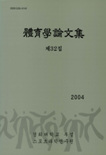- 영문명
- The Effect of Extracurricular Physical Programs on Students" Preference in Elementary School Physical Education
- 발행기관
- 경희대학교 스포츠과학연구원
- 저자명
- 이종희(Lee Jong-Hee) 한광령(Han Kwang-Ryung) 권형진(Kwon Hyung-Jin)
- 간행물 정보
- 『체육학논문집』제32집, 107~118쪽, 전체 12쪽
- 주제분류
- 예술체육 > 체육
- 파일형태
- 발행일자
- 2004.12.01

국문 초록
영문 초록
The purpose of this study was to examine the present state of elementary school students in extracurricular physical programs and its effect on their preference in school P.E. and to provide research materials which can be used to increase teaching efficiency. For this purpose, a questionnaire was completed by 410 fifth and sixth graders in 4 different school districts(Kang-nam, Kang-buk, Kang-dong and Kang-seo)in Seoul. The questionnaire was developed on the basis of the study and adjusted for the purpose of this study. The results of the questionnaire were analyzed by SPSS. The general characteristics of the subjects of the survey were presented through frequency analysis. The correlations between the subjects" preference in the sub-fields of P.E. and the participation in the extracurricular physical programs and gender were analyzed by χ² verification In addition, the t-test was executed to see the differences of preference in the sub-fields of P.E. The results were as follows. 1) The students who were not involved in extracurricular physical activity (Non-EC Group) outnumbered the students who participated in it(EC Group), In addition, more boys than girls were in the extracurricular physical programs. 2) In the EC Group, boys did Taekwondo most. And it was followed by swimming, soccer, basketball and Kendo. Girls also chose Taekwondo most. It preceded swimming, dance, sports dance and Kindo. Unlike boys, girls rather positively participated in expressive activities like dance and sports dance. 3) With respect to the correlations between subjects" attitudes towards P.E and the participation in the extracurricular physical programs and sex, EC Group and boys showed more preference, interest and positiveness than Non-EC Group and girls(p<.001). 4) With respect to the correlations between subjects" preferences in the sub-fields of P.E. and the participation in the extracurricular physical programs and gender, first, EC Group showed more preference for gymnastics than Non EC Group(p<.05). In addition, in the sub-fields of gymnastics, boys and girls liked mat activities (37.8%) and vaulting horse activities(227%) most respectively(p<.01). Secondly, in the track, there was no significant differences in the preferences between groups. Both boys and girls.
chose "relay" as their favorite activity. Thirdly, in the sub-field of game, soccer-related game was followed by skating and skiing. Whereas the soccer-related game was favored by both EC Group and Non-EC Group, the participation variable was significant in skiing and Taekwondo. The former was favored by EC Group. Moreover, gender affected the preference in the events of game activity. While 57.5% of the boys favored for the soccer-related game, 27.3% of the girls said "skating" was their favorite event. Preference in physical strength events differed according to participation variable as well as gender variable. Fourthly, the sub-field of expressive activity was least favoured by every group. Fifthly, in the sub-field of physical strength, "Exciting physical activity" was most popular. It showed that the participation in the extracurricular physical program and gender were analyzed as following. 5) The correlations between the elementary school students" preferences in the sub-fields of P.E. and the ① Compared to The Non-EC Group, the EC Group showed significant preference in the sub-field of gymnastics, game, track, physical strength activity. Therefore, it is proved that extracurricular physical programs can increase students" interest in these four sub-fields. ② Based on the gender variable, it was found that both boys and girls were most interested in the game activity. In case of boys, it was followed by track activity, physical strength activity, and gymnastics. In case of girls, it was followed by track activity, physical strength activity. In conclusion, elementary school students" participation
chose "relay" as their favorite activity. Thirdly, in the sub-field of game, soccer-related game was followed by skating and skiing. Whereas the soccer-related game was favored by both EC Group and Non-EC Group, the participation variable was significant in skiing and Taekwondo. The former was favored by EC Group. Moreover, gender affected the preference in the events of game activity. While 57.5% of the boys favored for the soccer-related game, 27.3% of the girls said "skating" was their favorite event. Preference in physical strength events differed according to participation variable as well as gender variable. Fourthly, the sub-field of expressive activity was least favoured by every group. Fifthly, in the sub-field of physical strength, "Exciting physical activity" was most popular. It showed that the participation in the extracurricular physical program and gender were analyzed as following. 5) The correlations between the elementary school students" preferences in the sub-fields of P.E. and the ① Compared to The Non-EC Group, the EC Group showed significant preference in the sub-field of gymnastics, game, track, physical strength activity. Therefore, it is proved that extracurricular physical programs can increase students" interest in these four sub-fields. ② Based on the gender variable, it was found that both boys and girls were most interested in the game activity. In case of boys, it was followed by track activity, physical strength activity, and gymnastics. In case of girls, it was followed by track activity, physical strength activity. In conclusion, elementary school students" participation
목차
ABSTRACT
Ⅰ. 서론
Ⅱ. 연구방법
Ⅲ. 결과 및 논의
Ⅳ. 결론 및 제언
참고문헌
Ⅰ. 서론
Ⅱ. 연구방법
Ⅲ. 결과 및 논의
Ⅳ. 결론 및 제언
참고문헌
해당간행물 수록 논문
참고문헌
최근 이용한 논문
교보eBook 첫 방문을 환영 합니다!

신규가입 혜택 지급이 완료 되었습니다.
바로 사용 가능한 교보e캐시 1,000원 (유효기간 7일)
지금 바로 교보eBook의 다양한 콘텐츠를 이용해 보세요!




